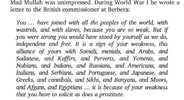“The Somaliland Burgher Contingent, consisting of Afrikaans and English speaking South Africans, was the first South African volunteer unit who fought on foreign soil. Volunteers hailed not only from South Africa but from Britain, Rhodesia, America, Ireland, Scotland, Canada and Austria as well. This truly cosmopolitan unit fought during the Third Expedition (1902-1903) in Somaliland against Mohammed Abdulle Hassan (1856-1920) – the so-called Mad Mullah.”

When South Africa’s Boers fought in Somaliland
Strange as it may seem, in 1903 there was a contingent of Boer (or Afrikaner) soldiers who served alongside the British in Somaliland. Here is the evidence, from a Reuters Report of the time. Clear…







